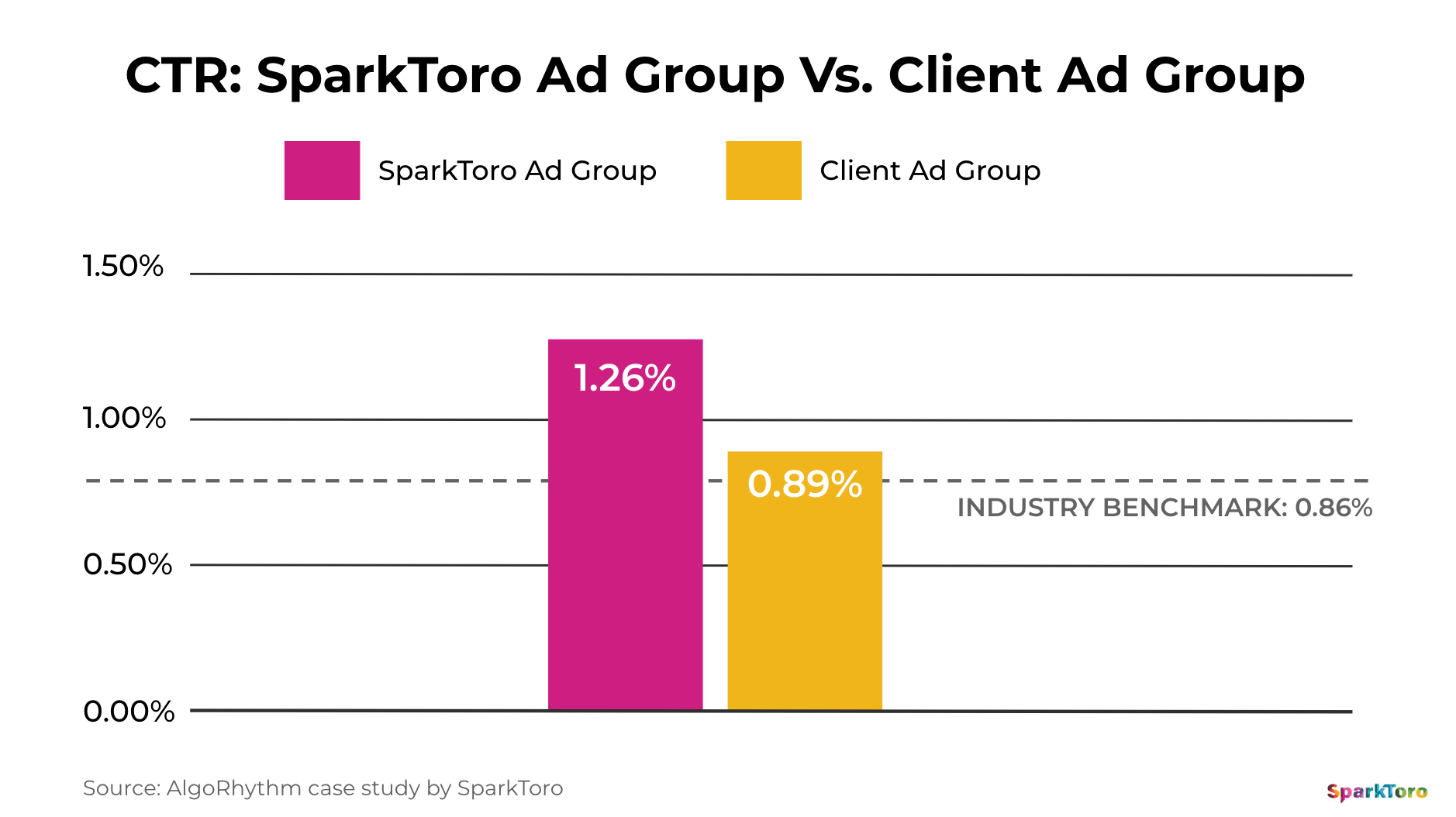Author: Justin Jon Thorne
Agency Tech Stack Spotlight – SparkToro
In our Tech Stack Spotlights, we walk you through some of the key tools we use to support our clients. First up, the incredible audience insights tool, SparkToro.
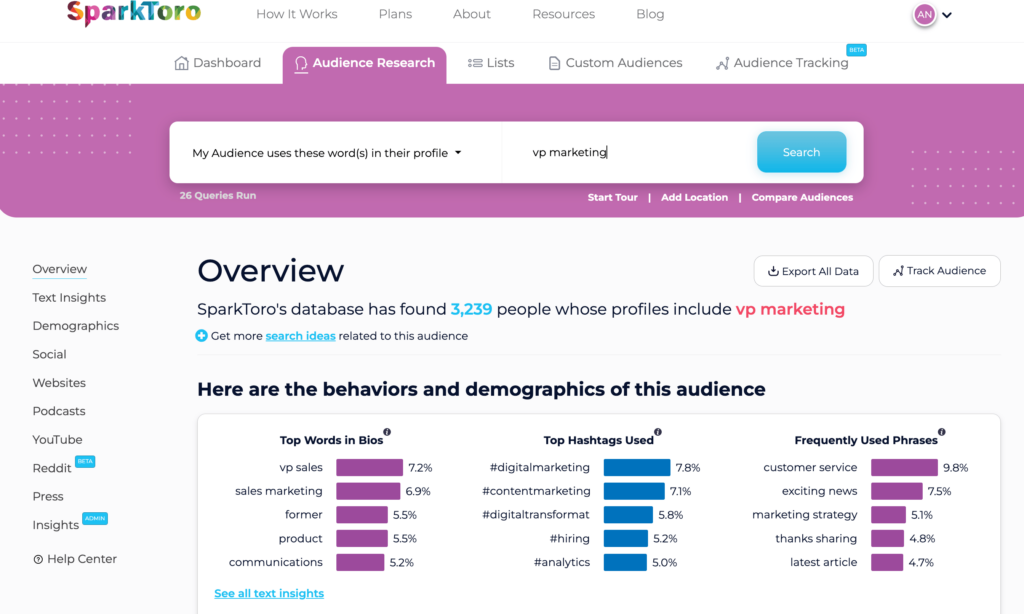
I’ve been following Rand Fishkin since 2010, since the days of SeoMoz’s (now simply ‘Moz’) whiteboard Fridays and as a consequence, I launched my first SEO agency, Black Page.
I’ve been a customer of Moz for just as long in multiple agencies and brands. It started my love affair with SaaS and let’s face it, all businesses these days are using cloud-based software for our daily tasks, whether that’s collaboration tools like Slack and Monday.com or specialist products like Moz and SEMRush to deliver our services for clients.
I was blown away by Rand’s cautionary tale of being a SaaS founder and his adventures with Moz are well documented – I can’t recommend his book, Lost & Founder enough for anyone thinking about founding a software company. It’s an authentic, warts and all tale about how he went from turning down $25m for Moz from Hubspot, to ultimately being fired by his own board. It also shines a light on the reality of working with VCs and scaling a two-person business into a market leader in a growing industry.
Like a phoenix, Rand emerged from the ashes of his 16-year career at Moz with his book and a teaser for his next SaaS project, SparkToro.
I signed-up to the newsletter when SparkToro was just a single page teaser website. When it launched, I signed-up as soon as I could and it is now firmly in my agency’s tech stack and frankly, it is brilliant.
Imagine you could identify the websites your target market visits, the social profiles they follow, the YouTube channels they watch, the Podcast channels they listen to and the Reddit, SubReddits they read. Then imagine you could dive into how they describe themselves in their bios and even the media outlets that influence them and even their political leanings.
That’s exactly what SparkToro provides and you start with either a keyword, a website or a social profile to generate these insights. When we are pitching, we use it to show that we really understand a prospect client’s audience and that of their major competitors.
Once we are working with a client, we use SparkToro to add genuine behaviour insights to personas. We all do personas in agencies and we’ve all seen the now classic Ozzy V King Charles comparison, which proves that whilst still useful, traditional segmentation does not tell you the whole story.
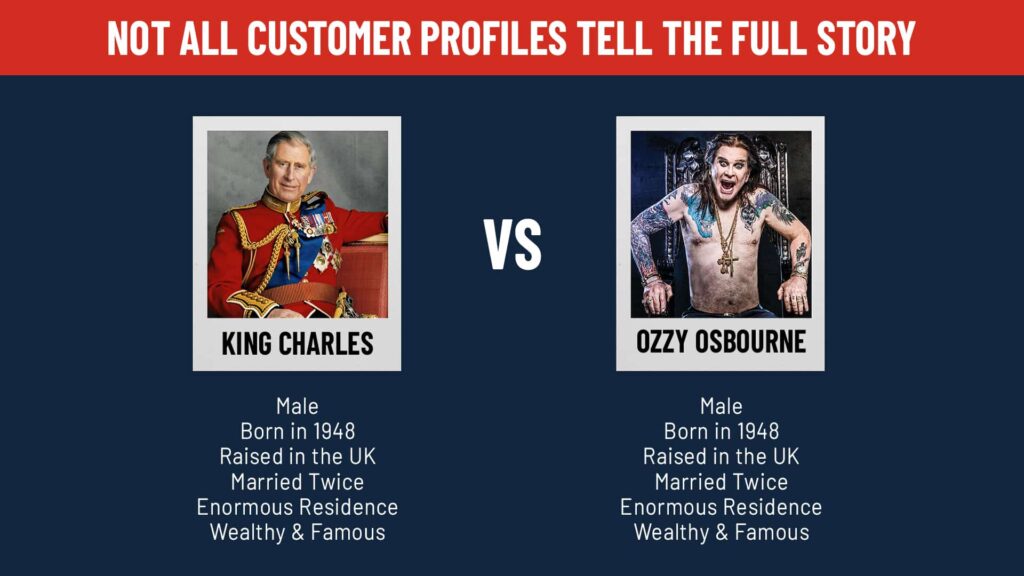
They both like red wine and holiday in the South of France, too.
The other super useful output from the platform is laser focused targeting methodology for both Twitter campaigns and Reddit paid ads. We’re essentially defining our audience in SparkToro, then applying the targeting into these ad channels and it has always delivered better CTRs and better engagement.
We were delighted to work on a joint case study with SparkToro following an experiment we conducted where we ran the same budgets to the client’s defined target audience in Twitter Ads, versus the list of social profiles identified in SparkToro. The experiment was made more challenging, given that the client’s audience was already delivering a CTR slightly above the benchmark of 0.86%.
The results were a 47% uplift in CTRs, 25% more followers and 17% more re-tweets. As we all know in agency world, we’re constantly looking for things to test and incremental improvements beyond creative, copy and landing page tests. SparkToro gives us such deep insights into audience behaviour, we can roll the learnings directly into the ad channels. You can read more about the case study here.
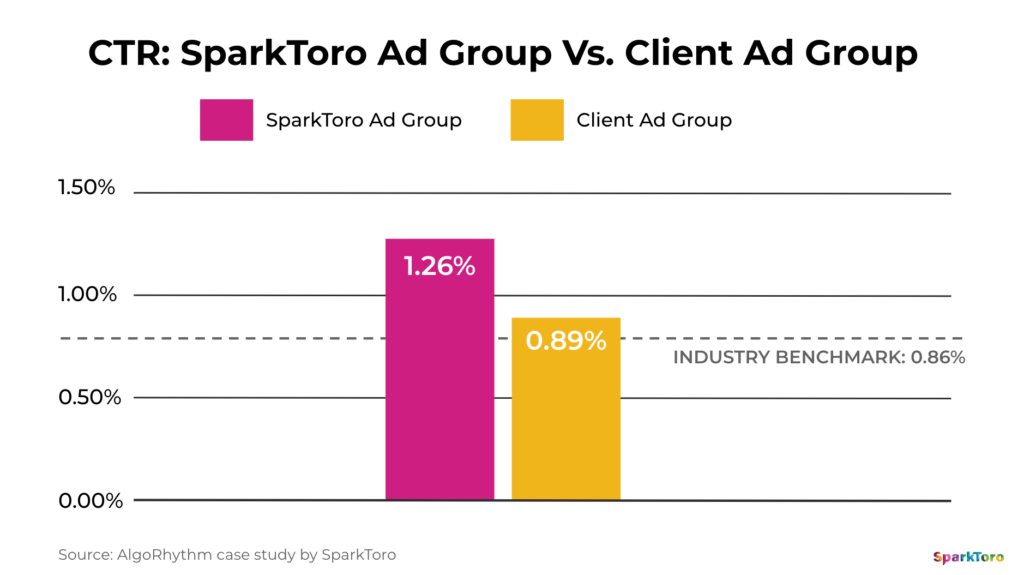
SparkToro is constantly evolving and rolling out new features and we’re keen to look into App insights – in a similar vein to the above channels, we can also look at what Apps our audience uses. We’re constantly using the platform to inform content, ad copy, personas, targeting methodology and help with pitches.
It’s an easy 10/10 from team AlgoRhythm.
Google Analytics Banned in Europe – the general consensus is ‘meh’.

We recently ran a content piece with the click bait title, ‘The Google Analytics Apocalypse is coming…’ This was primarily in response to GA as we know it, being officially sunset by Google this summer. Some of our clients have already made the switch to GA4 so we were already pretty familiar with the new layout but it has to be said, we’d always groan when we found they were on GA4, missing the familiarity and much easier navigation around it’s doomed sibling.
We’d already planned the piece and were ready to push it live, when we saw the muted, rather casual press that GA had effectively been banned in France and Austria and the Netherlands, Denmark, Norway and Italy were likely to follow. Excuse me, what now? How had that slid under the radar and why weren’t discussion forums, and LinkedIn for that matter flooded with concerned digital marketers?
At a conference recently, one of the [excellent] speakers mentioned GA’s European ban, spurring a lot of confused and slightly nervous looks from its audience of predominantly agency founders. The chap sitting next to me said, “GA4 fixes that though doesn’t it?”
“I don’t think so,” I replied – seems to be the way Google is sharing data into the US that creates the GDPR issue, so unless they change that for GA4, it doesn’t matter which version you are using.
So what actually happened?
A real life David and Goliath scenario, where lawyer, Max Schrems took on Facebook and then Google, for violating the privacy of European citizens – and beat them both in landmark court rulings.
The issue was exacerbated by silicon valley tech companies, basically ignoring the ruling that the privacy shield legislation had been invalidated, meaning they were not allowed to transfer data about European citizens to the US.
Max’s claim against Google, was concerning data captured by an Austrian health website. The fines have still not been issued but could be as high as 20 million euros or 4% of their turnover. That’s not a fine for Google… that’s the actual client collecting the data, i.e. that could be one of our customers or it could be you!
The issue is around the American CLOUD Act, which means US authorities, like the FBI, are entitled to demand personal data from the likes of Google and Facebook even for individuals living outside of the US. This breaches GDPR legislation. It is theoretically possible, Max argued, for him to be identified personally, using the subsets of data collected about him on the website and then passed by Google to US servers… bringing it into the grasp of US authorities. It didn’t matter whether they used it or not.
What do we need to do?
Well, it’s tricky. This isn’t just about US tech companies with European operations, if you are an organisation in Europe, and you have European citizens accessing your website, whether or not it’s an intentional target market, if you are using GA or GA4, Google is inadvertently breaching GDPR on your behalf and you get to pick up the fine!
There isn’t clear guidance, although some brands are already implementing technical measures, effectively passing their data through their own servers based in Europe, which anonymises data, or, and here’s a term for you for your next boardroom bingo session – ‘Pseudonymisation’.
I think the answer will come from our clients’ privacy and cookie pop-ups, i.e. when we ask users to opt in for marketing cookies etc. If a user is in one the of territories who have effectively banned GA, it will automatically turn the slider off for GA and they will no longer appear in your metrics.
Anonymous or incognito users will simply be ignored in GA tracking. Worst case, if you try and access a website from the parts of Europe putting their foot down, client websites will simply have to show a, ‘Sorry, we are not authorised to allow access to citizens based in X’ – but that seems crazy doesn’t it?
Will publishers switch from GA? Well the alternative platforms certainly hope so, and are drooling already. Just Google, ‘alternatives to GA’ and see what is happening.
Back to GA4 and the sunsetting of GA… which may simply be the harbinger of the apocalypse!
A lot of the ‘meh’s, are now becoming questions in forums or pleas for help. I’m seeing a lot of, ‘How do I set up tracking in GA4?’ and ‘How do I view organic keywords in GA4’ and ‘How do I ignore employee and agency visits in our metrics in GA4’ or simply, ‘What the hell, where has everything gone!?!’ One thing, which seems doomed, is assisted conversions data and true paths to conversion as Google is only really interested in last click attribution, as it wins that war hands down!
If you want to download our guide, click here or on the image below.
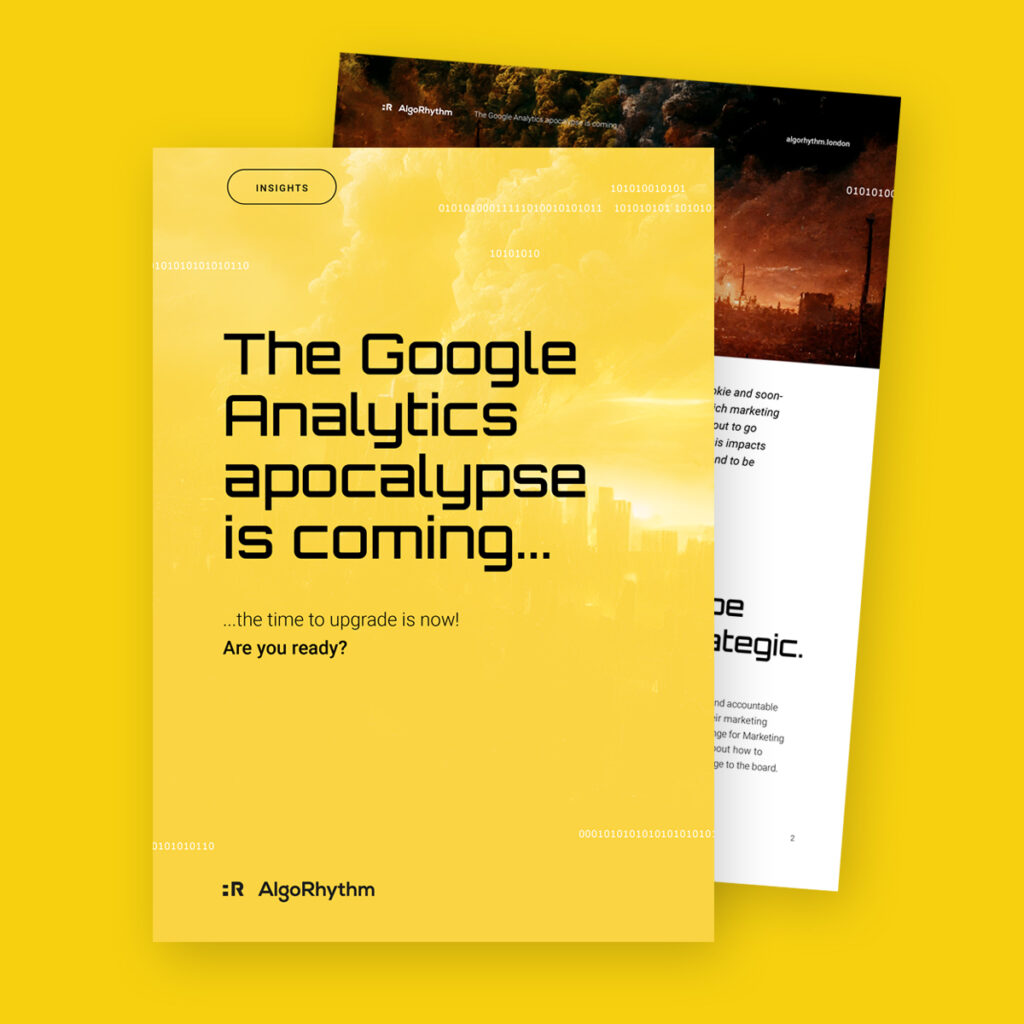
AlgoRhythm is now a toddler agency
It is bonkers that AlgoRhythm is now in its 5th year!

I describe myself as an accidental agency founder, because it’s totally true. I set-up a consultancy in 2018 and structured it as a limited company and before I knew it, I was charging clients for ‘the doing’ as well as ‘the thinking’ and asking my co-founder and wife, to leave her high paced job in Hyde Park property lettings to run the finances and credit control.
Next on my agenda, was convincing my now business partner, Paul Court, to join the agency and run the PPC and Paid Social teams. It took me a year, but I wore him down and we rebranded as an agency and stepped out into the world.
I wanted a brand that reflected our left brain and right brain thinking – we love the data, but we also love being creative and that’s where Algo (left brain) and Rhythm (right brain) comes from. With a brilliant bit of creative direction from our pal Ips, who is now working on some of the biggest movies and TV Show campaigns, our office mates, Bunker Creative took Digital Agency Rebels to the next level and we had an agency brand and website that truly represents who we are and how we think.
We hit our terrible two’s during the pandemic, which was excellent timing as 60% of our client base pretty much stopped trading until we came out of the first lockdown. The agency, like a lot of others I am sure, became a bit of a problem child.
Fast forward a couple of years, and year 4 saw 83% YoY growth (and was our biggest year even pre-pandemic!) I am so proud of the team and what we have achieved and the amazing client base we have built in that time. If I look back over the 4 years, the stats blow my mind for a small, boutique agency claiming to be Digital Agency Rebels.
We’ve invested £10m in media spend and driven £65m in revenue sales for e-commerce clients and thousands of leads for our tech and B2B clients. We’re now ready for our next stage of growth and that means aligning our strategy and processes with growth in mind.
One of the first big changes, and I am delighted to announce it, is that Paul Court is now Managing Director of AlgoRhythm. A much deserved promotion for an outstanding business partner and means Paul can focus on the day to day running of the business and I can focus on working on the business.

We’re still on the tools, Paul running PPC and paid social and building out and deploying campaigns and myself, focusing on the SEO consultancy and business development. I’ve coined the job title (or nicked it, I’m not sure) CSEO.
We’ve always been proud to sit in pitches and state that we don’t send in the A Team then hand the work over to the B Team. We couldn’t even if we wanted to, we are too small! The good thing about smaller, founder-led agencies is the founders can’t go anywhere!
So here’s to the next few years and I am sure before we know it, we will have a teenager agency on our hands with all the fun and learnings that comes from that stage!
How dare Malcolm Gladwell have an opinion on working from home

There’s been a couple of interesting ‘moments’ on LinkedIn for me lately, and in a way, I am delighted as LinkedIn has become a bit of an InMail nightmare for me – mostly folk selling me growth hacking, leads for my agency or worst of all… life insurance. Jeez, really? The only thing that keeps me on LinkedIn apart from running campaigns for our clients of course, is keeping up to speed with what my network are up to and the great content that they put out. But it is becoming less appealing. I absolutely reach out to people using InMails, especially when I am in the middle of a funding round, but it’s usually well researched and I make the effort to make my message as interesting as I can and relevant.
Anyway, the two moments. First and not really the topic of this post, is the crying CEO who posted an image of his tear streaked face, along with an emotional update on how, for the first time, he had to make some of his team redundant. Now, could be genuine, but seemed to me like someone making everything about themselves – poor me, had to fire some folk, but I’m such a good guy, look how it hurts me! The backlash was surprising – a stream of spoof posts, of crying individuals bemoaning their first world problems. My personal favourite, was the chap deeply emotional that he had missed the McMuffin deadline by five minutes and had to have a Big Mac for breakfast.

There was then a backlash on the backlash, as many LinkedIn members felt it was making light of what could be genuine mental health issues and as a community, we should be showing some empathy and compassion for those effected… if not the CEO with leaky tear ducts.

The second big moment, was Malcolm Gladwell’s chat with Steven Bartlett on The Diary Of A CEO podcast. Now, Steven is an incredible marketer, and it’s one of the reasons why he’s been so successful (not the only reason for sure) and he knew exactly what he was doing when he titled the episode, ‘Malcolm Gladwell: Working From Home Is Destroying Us!’ Steven knew what would happen when he threw this incendiary device of a title, into social media.
What surprised me, was the level of vitriol directed at Gladwell. There was definitely a healthy debate too, people could see the pros and cons of office working and working from home, we all have an opinion. But that’s the point, it’s subjective and we all prefer what works for us personally. It was the privileged view of some senior leaders who were aggressive in their attack that surprised me the most – it’s fine that you enjoy working from your plush home office, and only popping into Soho House to meet with clients when you need to.
But imagine you are in a small London flat, or house sharing. Imagine you are more junior in your role, it could be your first job. Imagine you aren’t from the UK and you are here working your ass off and you don’t have a social circle yet. What if you want to shadow someone with more experience and learn on the job… a task list and a screen is a pretty poor experience. And Zoom just doesn’t cut it.
I wonder if a lot of folk who reacted to the headline, even bothered to listen to the whole podcast? There was some incredible stuff on there about loss, about how neglect is the worst thing we can do to another human being (or animal for that matter) how contribution can drive happiness. And this is where Malcolm gets most animated and why he believes working from home isn’t great for company culture. We leave people out on the fringes, feeling neglected, they don’t feel part of something.
The really interesting thing for me, is that nobody called out or attacked Steven Bartlett for not only agreeing with Malcolm, but going on to say that he is thinking about making working from the offices of his own businesses compulsory and that he is asking employees and potential employees, where do you want to work? And if it’s at home, it probably won’t be for one of his enterprises. Controversial no? I don’t think so actually, it’s a brand choice and then the employees’ choice and as long as everyone knows where they stand, everyone is happy.
Personally, I believe that our job as employers, is to provide choice. If it doesn’t impact the output, mental health and culture, and you can make it work with parameters, let people work where they want. But I loaaaaaattttthhhh working from home. It’s my preference but I tell you what, since the pandemic and since we have become flexible, I am working from home 2-3 days per week and every time, it’s because I have an excuse NOT to face the commute, its too hot, I want to get a workout in mid morning, I have early morning calls and so on and so on. Usually though, it’s because I know the office will be empty. I crave social interaction, I love it, it’s the best part of working for an agency for me.
So, if a 5 x New York Times bestselling author, historian and anthropologist suggests there is a potential psychological impact of working from home, especially on younger and inexperienced colleagues, we should probably consider it and start planning how to do it better. We should probably start considering what companies, agencies and brands we want to be leading and growing, what culture do we want to finesse? It definitely isn’t as simple as letting everyone work from home three days a week and buying an enterprise Zoom license.
Do I wish I could piss off to Bali and become a digital nomad offering growth hacking services? Perhaps if I was 25 years younger and maybe that’s the point, maybe that’s what Gen Z want and our job is to help work out the kinks but interestingly, it definitely isn’t what all Gen Y and Gen Z want… some do want an office culture. Viva La Difference I say.
Digital Agencies Should Take a Punt on Start-Ups
One thing I’ve learned running agencies and leading teams in larger agencies, is that saying ‘no’ to potential clients can save you a lot of time and energy in the long run, for both the agency and the client.

In the early days of AlgoRhythm, it was really hard to say ‘no thanks’ or rather, ‘I don’t think we are the right agency for you’ as we really needed the business. Do you really want to say no to revenue, any revenue, even if you think you can’t help the client or worse, they are a nightmare to work with or even worse, the product is terrible?
Being selective really felt like a luxury and one we couldn’t afford, so we said ‘yes’ to everything. And it was a nightmare. We could tell that small fee clients were going to be really high maintenance. We could tell that some weren’t prepared to invest in the channels properly or had unrealistic expectations on ROAS.
Over servicing small clients is a real challenge for smaller agencies, you really want to do a great job and you really want to scale with your clients. But it’s simple math in the long run. If you’re only billing them for two days per month but the team is collectively chewing up five days, that’s three days you’re delivering for free that you could be charging out to another client. It’s all about capacity management and we all know how much the team LOVE using Toggl to track their billable hours!
The flip side of that though, is being too regimented with time, charging for meetings and updates or billing days over the retainer and that always felt like one of the things we wanted to change with AlgoRhythm. It’s why many of our clients came to a smaller agency in the first place. We’re on Slack, we can hop on a Zoom, we’re more agile and whilst I chase the team up for Toggl hours at the end of the month, I’m not asking the team to Toggl loo breaks!
Pitching is a big investment for agencies. We regularly pour 3-5 days collectively into a good pitch deck, including research, recommendations and often campaign creative. If we don’t win the pitch, we can’t charge anyone for that time, it’s the investment we make into potentially winning that business and we’re comfortable with it. By the way, we win a few too and we don’t charge the client for that time retrospectively either. Of course we have hit the ground running and can usually use a lot of the thinking and creative to really get the campaigns flowing.
Where am I going with this? Ah yes, so, as we evolved our brand into digital agency rebels and talk about pillars like authenticity and transparency, we often say ‘no’. Usually this is because we don’t think we can help, don’t think we can help with the budget in the RFP, or mainly because it’s not really our focus. We COULD do organic social, we COULD do influencer campaigns but our main focus is SEO, paid search and paid social. Very occasionally, we say no because we have a strict no asshole rule. Life’s too short, man.
However, one thing we have been doing a lot of recently, is validation projects for start-ups. What does that look like?
An entrepreneur has an amazing idea, they’ve developed a prototype app, or have a fascinating service idea and they want to validate the idea by testing the waters in the channels. So rather than investing 3-5 days into a pitch deck, we give them the agency to build out the creative and targeting methodology and run and optimise the campaigns in the channels to validate that, yes, the market wants the product and, yes, they can acquire the customer for a reasonable CPA. And they can use these metrics and insights to build out a far more accurate forecast for investors and show a demonstrable product/market fit.
On top of that, they also get interesting insights into what channels are working, what ad types and assets are working and the right copy approach.
What’s in it for the agency? Commercially, if you do an incredible job and the entrepreneur is successful in raising capital, you get to be that ‘agency fee’ line in the forecast and if you pick your start-ups and ideas well, they can be decent mid to large monthly fee clients. But it isn’t all about the fees, it’s just really interesting and fun to work on some of these incredible ideas. You’re dealing with smart, driven innovators and they usually have incredible networks. AlgoRhythm has had a few intros via these entrepreneurs that are now fully fledged clients.
We’ve helped a broad range of start-ups validate product/market fit from B2B SaaS and wellness apps, to full on ecom plays and social impact. We love it and yes you have to make sure you manage the time well and continue to do a great job for existing clients but I think it’s also an excellent way to keep the team motivated and flex their creative and technical muscles, especially if you let the team select the start-ups they want to help.
One of the projects we are working on in the NFT space (we actually have two NFT related projects on the go) was told by a mid size agency that they would need £150K to validate their idea. This is horseshit. We’ve produced amazing validation, with deep insights that informed P&Ls and forecasts with £500 media spend, 2 days of creative and 3-5 days of campaign implementation, optimisation and analysis.
We’ve also produced an incredible, fully animated and narrated explainer video and conducted twenty two, 30 minute in-depth interviews with enterprise CTOs and CMOs, for a software start-up where 100% of the interviewees wanted early access to the product. That cost about £1100 and a good five days of prep, interviews, analysis and interpretation.
The investments these start-ups are looking to raise, range from £1.5m up to £20m and in the GTM strategy there’s 3-5 years of runway for a creative and performance marketing partner.
So should digital agencies take a punt on start-ups? Yes they should, with eyes wide open and not purely for the bottom line but it is so… much… fun.
Getting to the first page of Google is even harder for SEOs

From around August 2021, Google quietly stripped out up to five organic results from the first page of SERPs (Search Engine Results Pages) for 18% of highly searched for keywords. Today, being in the top ten organic results does not guarantee a first page listing.
jT – AlgoRhythm
This is relatively old news to SEOs, although not discussed in abundance outside of SEO forums, but for the first time for AlgoRhythm, we’re seeing it impact some of our SEO clients. Google experimenting with SERPs is nothing new, and we’d regularly see 7 or even worse, only 5 organic results on the first page of Google as they tested out new ways to show snippets, answers to popular questions, image searches, Wikipedia entries and shopping results.
Why is position important?
It’s generally accepted that less than 10% of search users will click on a paid ad, which can still be highly lucrative for advertisers, especially for search terms with monthly volumes in the hundreds of thousands or even millions.
75% of users will click on an organic result on the first page of Google and 29% will click on the company in the number one slot. Around 16% will click on position two and 11% on position three, so it’s easy to see why clients and agencies are obsessed with getting into the coveted top three positions, and number one as the holy grail.
This means around 19% of users will go to page two and beyond.
We all receive emails from SEO agencies promising to get us into the first position of Google, even agencies like us that actually do SEO, but unashamedly leave our own SEO efforts on the back burner as we focus on delivering results for clients!
What is the impact?
For me, the most interesting data points are around user behaviour in terms of that 75% of users who previously would click on a result on the first page. Will we see more users prepared to go a little deeper and if so, will that benefit websites who were in the middle of page two, now that there could be more eyeballs on page 2? Of course this relegates websites that were previously at the bottom of page two, to the top of page three… were they getting any traffic anyway?
I think it’s more likely that the seven websites on page one, will now share that 75% of clicks, rather than sharing between ten competitors.
In terms of real estate, this will drive more advertisers to bid on terms even when they are in the top seven results as occupying two slots (one paid and one organic) is a great defensive move against competitors. You used to have 14 websites on page one, so appearing twice (one paid and one organic) took up 14% of real estate, now taking two slots is owning 18% of page one – if you have a snippet, a google shopping slot AND an image, you are really winning in the saliency stakes!
Why did Google do this?
Google will tell you that their core mission hasn’t changed, they want to match searchers with up to date and relevant information and most of their experiments with SERPs are testing out new UX for searchers. It is believed by some SEO commentators, that page one will end up looking more like a Wikipedia page than a search engine.
More cynical folk (hello!) will say it is Google driving more PPC revenue, by forcing even more advertisers looking for a first page listing, to find more budget for paid search.
Google are a business, so the reality is it is probably a bit of both.
What will we be watching for?
We’re very proud to have clients in the number one slot for their primary keywords, usually keywords we are actively producing content and guest posts for (to win those backlinks!)
We also have rankings in the 7-10 range so inline with my thoughts above, I’m keen to look into the data points around the impact on rankings in the first position – are we seeing click volume increase now three rankings are now on the second page? And for rankings that were at the bottom of the first page and now at the top of the second page, are we seeing users go deeper or are we losing click share?
What are you seeing?
Take a look at your primary keywords, are you still seeing 10 results, or now 7? Over time what is your impression and click share? What’s your thoughts and perspective around paid for ads with this change?
Neuromarketers love customers for their brains… yum!
“Neuromarketing is that shady bollocks, ‘that Cambridge mob’ used to get Trump into power and drive Brexit through, isn’t it?”
…said my less than enthralled prospect client. I quickly moved away from telling stories about nudges and sensory language before his eyes glazed over. We didn’t end up working together, which is probably better for the both of us.
There’s absolutely no doubt that neuromarketing opens doors to consultancy contracts and wins pitches and it’s a field that is growing in mystique and more importantly, demand. Good news for Lab, good news for me!
That being said, like all superpowers, it can be used for good or it can be used for evil. Without showing too much of my geeky side, it is just like The Force… you have your Jedis, like the folks at Lab – and you have your dark side, like the folks at Cambridge Analytica. Whatever its purpose, it’s the same force, it’s the same techniques and processes, it’s the same magic – it just depends who’s wielding the lightsaber!
Let’s cut through the mystique for a second. Neuromarketing is simply about understanding how human beings make decisions. The science bit is all about brains, hearts and balls. We have techniques that help consumers make decisions that allows them to weave wonderful narratives after said decision, providing perfectly feasible logic for exactly why they made that decision!
Neuromarketing allows marketers to run highly engaging, high performing campaigns that are more cost-effective and are actually useful and welcomed by consumers. So what’s the alternative in a world where we want to spend less and achieve more with our campaigns? Run ineffective, costly campaigns that annoy consumers… sounds great.
In Roger Dooley’s brilliant book, Brainfluence, and I am paraphrasing here, he describes how most marketing departments use marketers’ brains to try and influence outcomes from campaigns. Imagine if we could use the customer’s brain to influence the outcome… that’s neuromarketing!
But it’s more than that. Yes, we are learning more and more about how the brain works, how 95% of our decisions are made by our subconscious, but we are also learning more and more about how our emotions drive our decisions. In recent studies, scientists discuss the neuro network that exists in our stomaches… feel it in your gut, literally!
I love the science, but my passion isn’t what happens in the lab or what appears in the academic journals. My passion is testing this stuff out in the channels. That’s where the ‘balls’ come in. Fail fast, fail early or even better, transform performance with a simple tweak to your campaign. I use neuromarketing as lenses for my multivariate testing methodology, it’s really that simple.
The magic, is deciding which nudges to bundle together and a deep understanding of the audience you are trying to engage and what you want them to do.
That’s how we roll in the Lab.
Neuromarketing *rolls eyes*… the new snake oil?
At the customer-end of all this incredible technology at the fingertips of today’s marketers, is the most complex of systems – the human nervous system. Even compared to AI and Robotics, we are incredible machines. We’ve mastered the art of automation and optimisation over millions of years. We don’t need to think about breathing or how complex the tendon and muscle sequence is to walk forward… we can just do it.
Neuromarketing may seem like a relatively new flavour of Kool Aid, but how humans make decisions hasn’t changed for eons. What drives us, our motives, how we can’t make a decision without emotion, how we build a logical narrative after a decision and how our decisions and actions can be manipulated (for good and for bad) is nothing new to neuroscientists, psychologists and NLP practitioners.
Neuromarketing, at least how we see it at Algorhythm, is leveraging neuro principles, psychology and behavioural economics in marketing strategy (principally around persona motivation, fears and triggers) and in campaign creative and copywriting. At its most simple, neuromarketing simply provides the lenses for multivariate testing, rather than simply writing an ad three different ways with no real methodology, neuro gives us a codex of nudges and techniques to drive actions.
For us, the magic happens out in the channels and over the last four years we have seen paid search and social campaigns dramatically outperform historical campaigns by really understanding the target audience in terms of motives, by using neuro principles in the treatment of visuals, photography and illustrations and by testing behavioural economics and nudge theory in the copy. We’ll share specific examples and case studies in time and point you in the direction of great examples we are seeing out there in channels, as and when we find them.
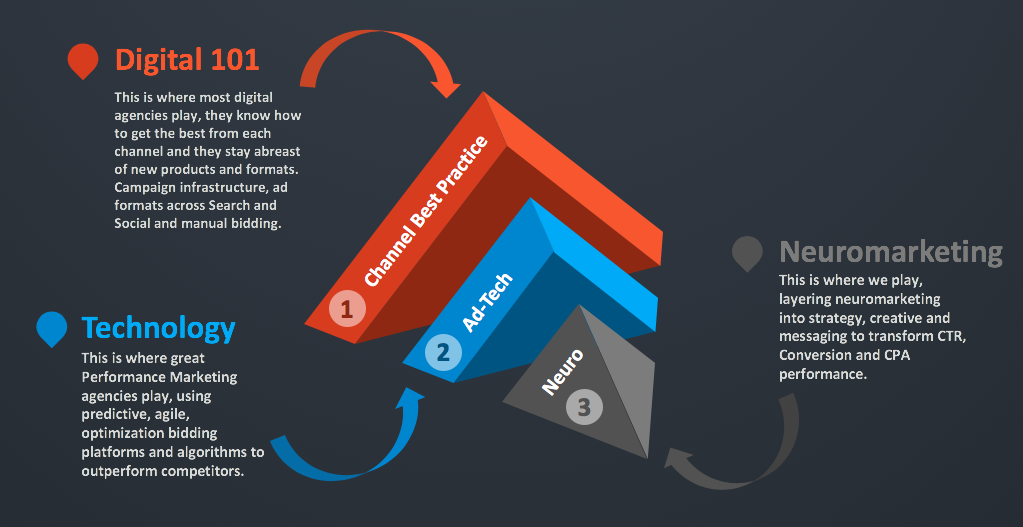
It does sound like secret sauce, but like all science, it’s actually methodical, has a process and really ignites when baked into the creative process. When I say creative process, I mean the research, ideation, creative and copywriting elements in campaigns. Neuromarketing should be in the DNA of the strategy, tactical and creative layers.
Clients buying neuromarketing are buying a process that is crowned with high performing campaigns and campaign assets.
When an agency top-down and bottom-up, is thinking, ideating, creating and deploying neuro principles in everything they do, it really is magical. It just makes sense and it’s because human understanding and our predictable unpredictability is at the heart of every touch point.
In the context of our consultancy, when we talk about neuromarketing, we are essentially interested in three areas.
1. Neuro principles on design, video, photography and illustration. Look at how Apple present their products, yes it’s art, but there’s science in the angles, proximity, how they show human and human emotion (usually on faces).
2. Persona Motives – this is an alternative to traditional segmentation. We still need to start with geo-demographics, as we need it for targeting, but imagine if you could define your customer’s intrinsic motives and by proxy, their greatest fears and you then crafted campaigns to use that to generate your desired actions, whether that’s a checkout, form fill or engagement.
Segmentation is a great start, but it can be deceiving.
Let me describe two men to you. Both male, British, in their 60’s, rich, love holidaying in Monte Carlo, love dogs and have lots of children. One is Prince Charles and the other is Ozzy Osbourne.
3. Behavioural Economics, Nudges and Linguistics.
Everything from confirmation bias, cognitive blindspots, social proof and anchor pricing to using sensory language, disruptive linguistics and cognitive load to create friction. I’m working on a codex of nudges that can be deployed in copy with Neuromarketing agency, Lab, so watch this space.
Every element of the above deserves its own blog post, so that’s probably the roadmap for future posts.
You are not an expert, a serial entrepreneur or a guru… but please coach me
One of the challenges facing any grumpy ranter these days, is that it’s really hard to share your rant in broader circles other than your friends and family, without sounding like a bitter, slightly hypocritical Victor Meldrew… or worse, some kind of ‘ist’ – in this case, age-ist.
At the same time though, self awareness is a super power and being self deprecating is cute, right?
I’ll also add, that I know many experts, serial entrepreneurs and gurus and none of them, and I mean NONE OF THEM, describe themselves as such. They may show those words in their LinkedIn profiles or on their websites, but the words come from the mouths of their customers, colleagues and peers in the form of testimonials and recommendations.
LinkedIn is a personal profile, it’s 1st person, you wrote it, we know you wrote it, we wrote our own profiles too… writing in third person that you are an ‘expert’ at anything isn’t fooling anyone and every time I read ‘I am an expert in…’ in my head I hear ‘I am a bellend…’
Look at the profiles of people you really respect, or even better, have mentored you… see how they talk about how they help xyz achieve xyz, tell us about the awesome projects you have worked on and the results you have achieved, but like ‘legends’, the platitude should come from others.
At this point, I will add, I’ve described myself as an ‘expert’ at various things over the years on LinkedIn and beyond, and I still blush about it… I posted my own Wikipedia entry too, before I realised what a HUGE douche bag move and faux pas that is… it took me ages to get it deleted, it’s like Wikipedia was punishing me by keeping it up for years… I went back in once to see if it was still live and a contributor had edited it, adding that I was a satanist, that I put on an American accent when I sing and that I claim to be a martial artist, but only spent one summer studying Kung-Fu… I am not a satanist, cheeky bastard! Thankfully, it is now deleted.
One of the incredible, revolutionary aspects of the internet, is that it allows anyone to have a forum and to find an audience. It’s wonderful and its brought us new thinking, collaboration, art in all its forms, destroyed the concept of boundaries and limitations and I love it with a passion.
Back in the dark ages, before Facebook, I completed my M.Sc. and my thesis was on the concept of social media. I predicted it was the future for consumers, the evolution of the modernist theory of opinion leaders and opinion formers (I didn’t see the power of influencers coming, or the concept of YouTubers becoming millionaires) but I incorrectly stated that it wasn’t the future for brands. I naively claimed that consumers didn’t want a conversation with brands and that brands should stay out of the conversation. What did I know? I was an academic, the last of Gen X and we all know where we are now with Kardashians and PewDiePie!
A boiled down, academic journal based on that thesis is available on my LinkedIn profile, called, ‘Genre Readers are Revolting’.
But, one of my peeves but also slight obsessions at the moment, is the endless stream of video gurus on LinkedIn, offering life coaching, simply because they have an iPhone and a LinkedIn profile. It’s remarkable, all of them have six packs and a life coaching businesses, shooting selfie videos of themselves in the car as each revelation comes to them. They get 10’s of thousands of likes and comments to keep them coming… wow. I guess I’m just not the target market, even though I am definitely part of the audience as I can’t resist listening to what they have to say.
Some of them actually say inspirational things, some of them are regurgitating inspirational things they have heard or read in a book, some of them ultimately are trying to sell Juice Plus (other pyramid schemes are also available) and most of them are ‘experts’ at something. I do believe the universe is magical, confusing, a kick in the balls one minute and a life changer the next, but I don’t believe you get anything by asking the universe or putting it out there, you get it by getting off your arse and taking it.
There’s an old saying, ‘Don’t trust a skinny chef’ – the inference being, that their food must be awful. Of course, this is nonsense, there are plenty of skinny and even buff, Michelin Star chefs out there… but when it comes to life coaching, I personally, want advice from someone who has lived more than a quarter of theirs! Is that ageist? Maybe. Can you learn something from Gen Y and Gen Z… Absolutely!
There has to be a value exchange. Your audience’s currency is their time, they invest it in your content and they need to be able to take something away from that investment. It may be your services, it may simply be your story or your sentiment (I feel that way too!) but there has to be a purpose.
All these video gurus offering courses on how to become millionaire video gurus are only millionaires because people want to become millionaire video gurus… they are only experts in converting and selling to people who want to be just like them. They may have some interesting things to teach you about video production, hooks or storytelling that are transferable to selling YOUR product to YOUR market but it’s much more likely that your end consumer isn’t like you at all.
Here’s my final take-away, and it’s old fashioned I know:
be authentic, always ask yourself why anyone should care about what you have to say and finally, make sure there is value in what you produce, a genuine exchange.
Trust me, I’m an inspirational, serial entrepreneur and expert in being a guru*.
*lie.
